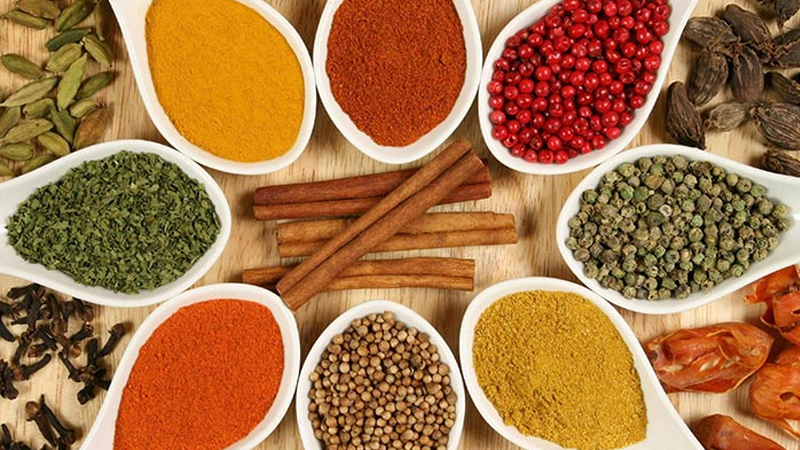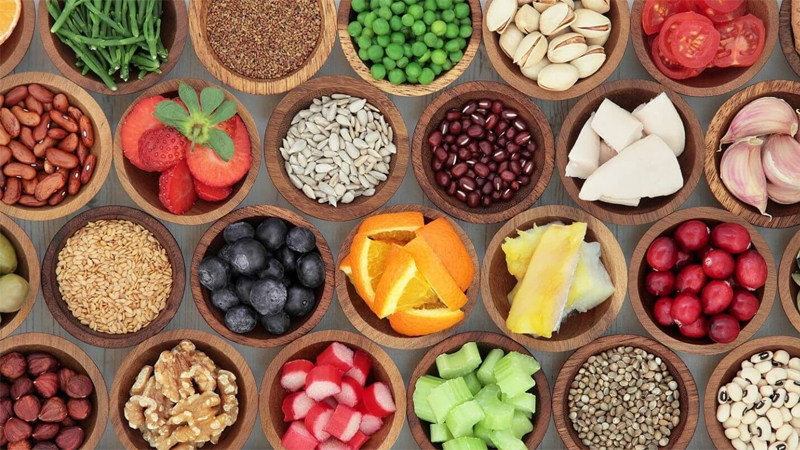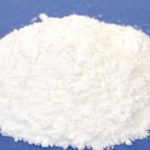Food additives are commonly used to enhance and preserve food products. To learn more about these additives, read on!
1 What are Food Additives?
 Food additives help preserve food products.
Food additives help preserve food products.
Food additives are substances, either natural or synthetic, that are added to food to preserve it.
With the advent and growth of the food processing industry in the latter half of the 20th century, many food additives were introduced.
These additives may be of natural origin or synthetically produced, such as sodium bicarbonate. Some are also derived from microorganisms, like the enzymes used in yogurt production.
Additionally, additives can include vitamins added to fortify the nutritional content of food products.
The purpose of food additives is to intentionally alter food or beverages to prevent spoilage, prolong shelf life, and enhance flavor or texture, all without altering the inherent quality of the product.
They are also used to make products more appealing to consumers by adding crispness or a desired color.
Typically, food additives are not consumed as food themselves and are only used as a minor component of the final product.
For instance, food additives are commonly found in products like powdered milk, cream, breakfast cereals, and fruit jams.
There are various types of food additives available in the market, including preservatives, sweeteners, colorants, flavor enhancers, thickeners, and emulsifiers.
2 Benefits of Food Additives
 Benefits of food additives.
Benefits of food additives.
They offer several advantages, including:
- Diversity: Additives enable the creation of diverse food products to cater to varying consumer preferences, tastes, and demands.
- Preservation: They help maintain the quality and freshness of food until it is consumed.
- Convenience: Additives facilitate food production, processing, and enhance the marketability of the final product.
- Extended Shelf Life: Food additives prolong the shelf life of products, reducing waste and ensuring a consistent supply.
3 Harmful Effects of Food Additives
 Potential harms of food additives.
Potential harms of food additives.
While beneficial, the excessive or improper use of food additives can have detrimental effects:
- Acute Toxicity: Overconsumption of certain additives can lead to acute toxicity.
- Chronic Toxicity: Regular consumption of small amounts of certain additives can lead to their accumulation in the body, causing long-term harm. For example, the consumption of food containing “han the” (a type of food additive) can lead to symptoms such as loss of appetite, weight loss, diarrhea, hair loss, chronic kidney failure, pallor, epilepsy, and reduced intelligence.
- Carcinogenicity: Some synthetic additives are linked to an increased risk of cancer, genetic mutations, and birth defects.
- Nutrient Depletion: Certain additives can destroy essential nutrients and vitamins in food.
4 Permitted Food Additives
Preservatives
 Preservatives help extend the shelf life of food.
Preservatives help extend the shelf life of food.
Preservatives are substances that prevent food spoilage and prolong its shelf life by inhibiting the growth of microorganisms and slowing down natural chemical changes that affect flavor and edibility.
They can be divided into two main categories:
- Natural Preservatives: These are commonly used in food processing and preservation. They not only enhance the flavor and color of food but also act as preservatives by absorbing excess moisture, killing bacteria, and preventing oxidation and microbial growth. Examples include , , , , and others. Additionally, methods like refrigeration, drying, and fermentation are also used to preserve food naturally.
- Artificial Preservatives: These additives are essential in the food industry to maintain the flavor, texture, and appearance of processed food products. They are commonly found in canned foods, beverages, and , with labels listing additives like BHT, , sodium nitrite, sodium benzoate, potassium nitrate, and acid benzoic (E210). Artificial preservatives are further categorized into three groups: those permitted for use in food and beverages (e.g., yellow colorant E104), those with low toxicity levels, and those prohibited due to their use in paints (E103).
Food Colors
 Food colors enhance the appearance of food products.
Food colors enhance the appearance of food products.
Food colors, or color additives, are used to restore colors lost during food processing or to enhance the appearance of naturally colorless foods.
The U.S. Food and Drug Administration (FDA) and the European Food Safety Authority (EFSA) have approved the following food colors:
- Erythrosine (Red 3): This cherry red color is used in products like , icing, and decorative gels.
- Allura Red (Red 40): With a darker red shade, it is commonly found in products like , candy, seasonings, and .
- Tartrazine (Yellow 5): This lemon yellow color is used in candies, , potato chips, popcorn, and cereals.
- Sunset Yellow FCF (Yellow 6): With an orange shade, it is used in candies, sauces, roasted foods, and preserved fruits.
- Brilliant Blue FCF (Blue 1): This turquoise color is used in ice cream and packaged foods like soups and beans.
- Indigo Carmine (Blue 2): With a dark blue shade, it is used in candies, ice cream, cereals, and snacks.
However, it is important to note that some colors are banned in certain countries; for example, Green 3 is permitted by the FDA but prohibited in Europe, while Quinoline Yellow, Carmoisine, and Ponceau 4R are allowed in the EU but banned in the U.S.
Stabilizers
 Stabilizers maintain the consistency and texture of food products.
Stabilizers maintain the consistency and texture of food products.
Stabilizers, or food stabilizers, are additives that maintain the structure and uniformity of a product by preventing the separation of emulsions, like oil and water, when mixed together.
They are commonly used in canned products, beverages, , seasonings, and confectionery.
Some commonly used stabilizers include:
- E471 and E418: These additives prevent the separation of milk powder (milk fat) and water, keeping the milk proteins suspended instead of floating to the surface.
- E410: This sweet-tasting additive is often used in sweet products like .
- E409: It is commonly used as a thickening agent in products like , , chocolate, confectionery, sauces, frozen fish, and sugar-free foods.
- E401: This additive is frequently used in baked goods, dairy products, sauces, and meat-based dishes.
Leavening Agents
 Leavening agents are used in baking to make products airy and fluffy.
Leavening agents are used in baking to make products airy and fluffy.
Leavening agents are substances that cause the expansion of dough or batter by releasing gases, resulting in a light and fluffy texture, especially in baked goods.
They can be categorized as follows:
- Baking Powder: This is a mixture of a heat-activated leavening agent, an acid in a specific amount, and a starch like cornstarch.
- Yeast: A living microorganism that produces carbon dioxide during fermentation, causing dough to rise.
- Baking Soda (Sodium Bicarbonate): A component of baking powder, it helps baked goods rise and become airy.
Flavor Enhancers
 Flavor enhancers improve the taste of food products.
Flavor enhancers improve the taste of food products.
Flavor enhancers, or flavoring agents, are added to food to replace or enhance its natural flavor, which may have been lost during processing.
They can be categorized as follows:
- Natural Flavoring Substances: Derived from plants or animals through physical, microbial, or enzymatic processes, these are used directly and in their natural state. They can produce edible substances like fruits, , milk, meat, , and more.
- Flavoring Substances with Natural Characteristics: These are synthesized and concentrated through chemical and physical processes, resembling natural flavoring substances without containing any artificial flavoring agents.
- Artificial Flavoring Substances: Derived from inedible substances like petroleum or coal tar through chemical processes, these mimic the flavor of natural food products.
In addition to the above, sweeteners, antioxidants, acid regulators, anti-caking agents, and emulsifiers are also permitted for use as food additives.
5 Harmful Food Additives
 Some food additives can be harmful to health.
Some food additives can be harmful to health.
Here are some specific examples of harmful food additives:
Antibiotics in Dairy Products
According to nutritionist Ashley Koft, unless you’re consuming organic dairy, products like milk, yogurt, and cheese are likely to contain antibiotics and hormones from the cows they came from.
Daily consumption of these antibiotics can kill beneficial gut bacteria, impacting our immune system, and also contribute to weight gain by increasing waist circumference.
To avoid this, consumers should read labels carefully and opt for dairy products labeled “hormone-free” and “antibiotic-free.”
Chemicals in Canned Foods
A study by the Consumer Reports Program (USA) found that 19 brands of canned products contained chemicals linked to breast cancer, diabetes, and heart disease.
Dr. Urvashi Rangan emphasizes that even small amounts of these chemicals are dangerous. Therefore, it is advisable to opt for fresh produce, foods, and heated meals stored in glass containers instead of canned goods.
Sodium in Salad Dressings
Salad dressings often contain high levels of sodium, which can lead to water retention and a feeling of bloating.
Experts recommend using 1,500-2,300mg of sodium in dressings or combining them with or in a 2:1 ratio.
As salt is a well-known health concern, it is essential to limit its consumption and prioritize its use for food preservation.
Excessive salt intake can lead to cardiovascular issues, high blood pressure, heart attacks, strokes, and kidney damage.
 Harmful effects of food additives.
Harmful effects of food additives.
Fructose in Soft Drinks and Packaged Products
The consumption of foods and beverages high in fructose is linked to an increased risk of hypertension. A study by the University of Denver found that individuals who consumed approximately 74mg of fructose daily had a higher risk of developing hypertension than those who consumed less.
High
“How to Keep Fresh Flowers Arranged for Up to 3 Days Without Overwatering”
It’s almost that time of year again – Tết! As you adorn your home with gorgeous and vibrant flowers, you may be wondering: how do I make sure they stay fresh for as long as possible? If you’re not familiar with the right care techniques, your flowers can fade and start to wilt in as little as one or two days. Don’t worry though, we have some tips here to help keep your flowers looking beautiful for the duration of the festive season!






































